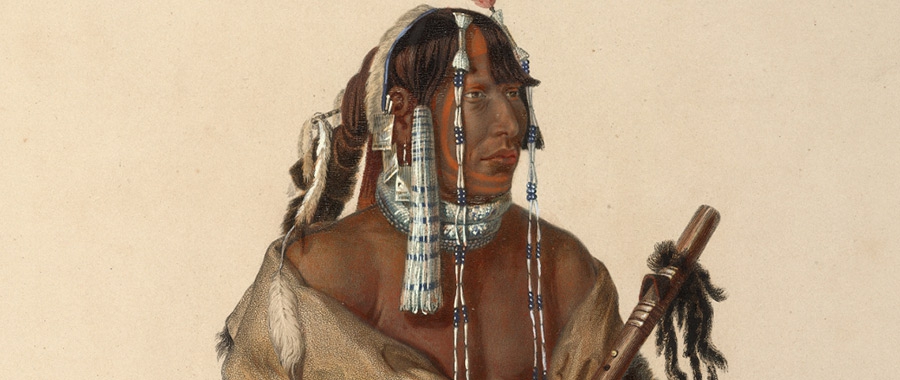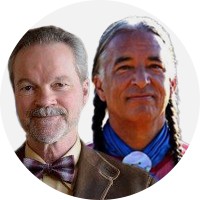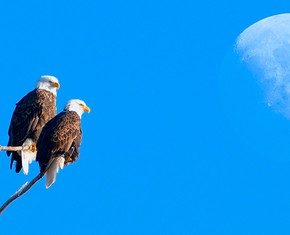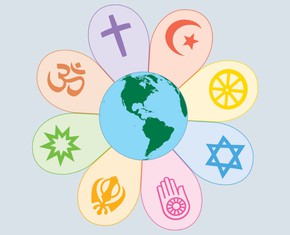The views expressed in our content reflect individual perspectives and do not represent the authoritative views of the Baha'i Faith.
In this installment of the Indigenous Messengers of God series, Kevin Locke explores the nobility and spirituality of the sacred traditions of the Mandan tribe and their holy figure Lone Man.
Q: Kevin, what can you tell us about your experiences with the sacred Mandan traditions?
A: After having driven past it countless times, over 25 years ago I decided to hike up a sacred hill, which dominates the horizon about 10 miles south of the city of Mandan, North Dakota. Shortly after that experience, while visiting a Mandan elder, I mentioned the hike. Immediately she asked several questions about Eagle Nose Butte: “Did you see that it is like a crater at the top? Did you see that all around the perfectly circular top edge of the crater grows ground cedar? Did you see that the center of the crater is covered in sand?”
I asked her: “When did you last visit there?” She responded: “Oh no, I’ve never been there. My grandparents would make pilgrimage there every year, but said that it is such a spiritually powerful place that I was too young and should wait until I was mature, then I could go and pray as they dutifully did annually. I regret that I never did make the pilgrimage there because they would describe the place in great detail. I’m glad that you were able to pray there.”
She then volunteered that another site they would make pilgrimage to is just south of the Cannonball River on the east side of Highway 1806—the place where Lone Man’s ark first made landfall. She indicated that these were all sacred duties performed in reverence to the covenant of Lone Man.
Q: Lydia Sage-Chase, the youngest of the five remaining full-blood Mandan Amerindian people, is a Mandan “keeper” of the Mandan stories and traditions, commissioned to prepare presentations of Mandan oral tradition for the archives of the Library of Congress in Washington, D.C.
Ms. Sage-Chase described that tradition this way:
The Mandan believe that all life comes from one Creator, All is related. The ideas of generosity, cooperation, and goodness towards others are everybody’s responsibility so that the Creator’s gift of life will go on. … The world is generous, and when one is generous the world returns that generosity.
Speaking of Mandan values as virtues, Ms. Sage-Chase further said:
From the teachings there come many values for all people to live by, our notion of the peoples generosity goes back to the time of the Creator. The produce of the gardens, corn, beans and squash, the produce is not given just for ourselves, but for other people, to feed other people, to share with other people. Sharing meant that there was, must be a trade-off with the other nations, tribes.
At presentations people sometimes say to me that Indians didn’t know anything before whites came. That is not so, we have a complex language with different language for men and women. Our number system has been used since the beginning of time. We know botany, knowing the true value of plants and the use of them. We are environmentalists, protecting the environment we live in. We believe the Creator lived amongst the Mandan and taught us all these things, taught us everything. – from Philip Arthur Zemke, “Mandan Amerindian Culture: A Study of Values Transmission,” 1994.
This summarizes what Lydia Sage-Chase taught about “Lone Man” as paraphrased by Zemke:
First Man appeared many times among the Mandan, but is now said to no longer come in physical form, as he has gone to live in the south. … The reason that First Man ceased coming to the villages may be that the innovation of consolidated fortified villages, with his shrine at the center, was recognized as a final entity of Mandan social organization. The consolidated villages brought the clans into a unified blend, and, the age-grade societies of non-blood related individuals secured an intra-village fidelity of mutual military support and coordination of garden production. The solidarity of social structure would not however have ended the need to continue to interpret the social rules First Man originated. Subsequently, when his guidance was needed the Mandan followed his example as the Lone Man, and they wandered in solitary vigil sending thoughts upon thoughts to him. Each Mandan striving to come to a “single mindedness” so that they might hear his advice. – Ibid., pp. 74–75.
Kevin, what parallels do you see between the Mandan teachings of Lone Man and the Baha’i sacred teachings?
A: As for Baha’i sacred teachings, the following statement by Baha’u’llah might go well with the part above about hearing the voice of God while in solitude:
I am well aware, O my Lord, that I have been so carried away by the clear tokens of Thy loving-kindness, and so completely inebriated with the wine of Thine utterance, that whatever I behold I readily discover that it maketh Thee known unto me, and it remindeth me of Thy signs, and of Thy tokens, and of Thy testimonies. By Thy glory! Every time I lift up mine eyes unto Thy heaven, I call to mind Thy highness and Thy loftiness, and Thine incomparable glory and greatness; and every time I turn my gaze to Thine earth, I am made to recognize the evidences of Thy power and the tokens of Thy bounty. And when I behold the sea, I find that it speaketh to me of Thy majesty, and of the potency of Thy might, and of Thy sovereignty and Thy grandeur. And at whatever time I contemplate the mountains, I am led to discover the ensigns of Thy victory and the standards of Thine omnipotence.
I swear by Thy might, O Thou in Whose grasp are the reins of all mankind, and the destinies of the nations! I am so inflamed by my love for Thee, and so inebriated with the wine of Thy oneness, that I can hear from the whisper of the winds the sound of Thy glorification and praise, and can recognize in the murmur of the waters the voice that proclaimeth Thy virtues and Thine attributes, and can apprehend from the rustling of the leaves the mysteries that have been irrevocably ordained by Thee in Thy realm. – Baha’u’llah, Prayers and Meditations, pp. 271-272.
Q: I just came across this remarkable vision, recounted by Elizabeth Fenn in her 2015 Pulitzer Prize-winning history Encounters at the Heart of the World: A History of the Mandan People:
The Red Feather Man’s Okipa—like all such ceremonies—begin with a vision. In it, a holy man approached and revealed what was to come. Cedric saw an Okipa lodge with people lining up to go inside. “I saw men and women,” he recalls. “I saw Indians and non-Indians. I saw people from the five races of mankind—Red, Yellow, White, Black, and Brown. What mattered, the holy man said, was not skin color but quote the heart of the individual.” Those with “a good heart” would “enter the Okipa lodge. They must have the genuine love of mankind, and they must have humility.” – Cedric Red Feather, also known as the “Red Feather Man,” a Nueta (Mandan) Waikena—a Mandan turtle priest—and a modern-day Okipa Maker, quoted by Elizabeth A. Fenn, Encounters at the Heart of the World: A History of the Mandan People, p. 336.
Fenn concluded by noting:
Thus it was that some sixty people of all hues gathered at On-a-Slant Village on June 11, 2011, to fulfill Cedric’s Okipa vision. The Black Mouth Soldier Society, The White Buffalo Cow Society, and the Goose Society were all present. … The Okipa suited the vision that inspired it. There was no piercing, no dragging Buffalo skulls. But Lone Man made his entry, and all the creatures came back. From morning to midnight, we danced and we danced, pausing to smoke, pray, tell stories, and ponder the Mandan way through the world. – Ibid.
So here’s my question for you, Kevin: Isn’t the Red Feather Man’s Okipa vision perfectly harmonious and resonant with the Baha’i vision?
A: Yes, indeed. I agree! Just as “Lone Man made his entry,” the spirit of Baha’u’llah is present in Baha’i sacred gatherings, like devotionals that Baha’is host and hold in their homes and neighborhoods around the world.
















Comments
Sign in or create an account
Continue with Googleor